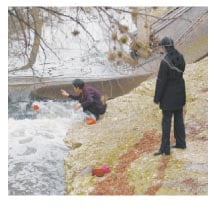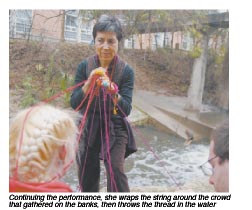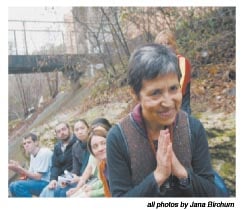Seeing and Gathering
A slate-gray sky shimmers on the surface of Barton Springs, while the pale white bodies of a handful of swimmers glide through the water.
Chilean artist, filmmaker, and poet Cecilia Vicuña plunges her hand into the creek without hesitating. “I could swim here!†she cries. “In Chile, the water is so cold, you put your foot into here,†she says gesturing to her ankle, “and all of your bones ache.â€
It’s not surprising to see Vicuña at the water’s edge, testing the currents. She makes art by making connections to a place. Recently the Blanton Museum of the University of Texas brought her to Austin to recreate an installation that she did here in 1987.
The installation consists of small sculptural objects crafted from found materials such as feathers, stones, Chilean driftwood, shredded plastic from the streets near her Manhattan apartment, wires, shells, and bones. In their fragile, asymmetrical arrangements, they look as much like IndoAmerican artifacts as 20th century conceptual art. She calls these pieces precarios, a word that in Spanish connotes both a precarious object as well as a something “obtained through prayer.†She also refers to them as basuritas, or “little pieces of garbage,†because they are made from refuse.
Despite their diminutive names, her works have been exhibited at the Palais des Beaux Arts in Belgium, at the Castello di Rivoli in Italy, and in the l997 Whitney Biennial.

Ever since the 1960s, when she began creating performance art on Chilean beaches, water has been an instrumental element of both her poems and visual art. So, it was only fitting that while in Austin, she found time to visit the city’s most famous watering spot. The following is an excerpt from a conversation that took place over the course of several days during her stay in Texas.
Texas Observer: You have been making art since the late 1960s. What is it like to come back and work again on a piece you originally did in the mid-1980s?
Cecilia Vicuña: Most of the objects had survived in storage at the Blanton, which is rare since these objects are very precarious: I don’t use glue. Things balance one on top of another. They travel, they can get lost, and they suffer just like people. When I took them out of storage, I realized that I didn’t want to arrange them in the same way. So the piece came out completely different. Many of the originals I didn’t even use. I included debris I found from here in Austin.
The basuritas themselves, these little pieces of garbage or debris, have what Proust would describe as a spell: You touch them and each one has a story. Each one recalls an instance; each one recalls the time of its creation. Although I created the installation here in 1987, I found most of the objects in 1984 or 1985. I was living in New York and it was very difficult for me. I was bringing a lot of debris from Chile, transporting debris across borders. So I started to combine the debris from New York and Brooklyn and Chile. Everywhere I went we created a sort of palimpsest of debris from all of the places I had visited. For example, one of the pieces that survived at the Blanton is from a beach in Chile. There’s a lot of debris from dead birds in that area. You see less and less birds and more and more plastic on the beaches of Chile. I remember when I collected those pieces. At that time, the beach was entirely undeveloped, like it was when I was a girl. Now it’s entirely built up. It’s amazing the degradation of the landscape in Chile over the last half century.
TO: These are pieces that were created in the mid-to-late 1980s, when we were still in the Cold War and living under the Reagan administration. I want to say so much has changed, but I don’t know. Now we are living under another conservative administration and the precariousness that felt exemplary of the Cold War has been substituted for a very different kind of insecurity.

CV: One of the pieces I created here is a clear reference to the Twin Towers—I live at the foot of the towers. I went down to the storeroom of the Blanton Museum and found these fragments of venetian blinds. They immediately reminded me of something that I wrote after September 11, 2001. A Chilean newspaper had asked me to write a testimony about the attack. I wrote that the reaction to the attack was even worse than the attack, because as Gandhi has said, “An eye for an eye and the world will be blind.†For me, these blinds are a perfect metaphor for what the U.S. citizens have chosen. And this choice is very dangerous for the whole world. I think that everybody in the world felt that it was not just the American people who were under threat, it was the world itself. But it is not because of the attack by terrorists, the world itself is in danger because of its unwillingness to see the reality of inequality, the reality of pain.
SB: In the United States, we don’t have a relationship to ruins like other cultures do. In the case of the World Trade Center, it occurs to me that they took those ruins down and cleared them away at an amazing speed. And that site is totally sanitized now.
CV: It is denial. It’s denial of death. It’s denial of pain. It’s denial of who we are. This is why I work a lot with water because you cannot deny your own process. Being human is becoming debris. We are here so briefly. And we don’t wish to see what we are leaving behind: We are leaving all this garbage, all of this dirty water. The Texas coast, for example, is becoming a dead ocean because people are unwilling to recognize the process of water pollution. Debris is also a metaphor for being human: You live to let someone else come and live and die. The human chain is unbroken. It goes as far as we can possibly imagine and it will go as far as we are willing to let it go. But, if we don’t want to think about it, it will come to an end very soon.

SB: It seems that we are more precarious than we were in the late ’80s.
CV: Certainly, because this unwillingness to see is becoming more powerful. In this upcoming election we will really get to see where the American people are. The perception of people outside of the United States is that the American people don’t want to see reality. It is patriotic to ask: Why is this happening? What happened to American democracy and the will of people to question? Democracy is like a poem, if you don’t use it, it disappears. The media and the powers have found a way to speak about democracy as if it were a given, something that is already here. That’s a substitution of reality. It represents a desire to see an image instead of what is real.
SB: What does the debris tell you about a place?
CV: The first thing I want to know is where the water comes from in a particular community. What are people doing to their water? How are they relating to their water? This is a true indication of how people combat their own life, how they combat their own bodies and food. In Austin, I saw a wonderful sign in a gas station that said: “Each driver is responsible for their own fluid.†I thought it was so perfect, because we are the drivers of our own flesh. We are responsible for our own fluid. When I was younger, I wrote that what goes in and out of the body should be the foundation of loss. If we were to see this process of entering and exiting, then we would have respect for the chain of transmission that is life.
SB: What was it about your own artistic sensibility that leads you to think about water in your art and your poems?
CV: Well, I was born by a river in a place near the Andes Mountains. I played with the river like kids today play with video games. I played with running streams. I spent my whole childhood with water. I listened to it. At night, the streams were full of these little frogs; they made incredible music at dusk.
And all that has gone silent, they are all gone now. Chile has managed to undo the streams, undo the frogs, and undo the music.
SB: Your sculptural pieces come from your own seeing or witnessing. They are created in a particular setting or culled from the materials of a particular place.

CV: When I come to a museum, I use the museum as my workshop. The museum becomes my studio, the city becomes my studio. Where is my studio in time or in space? Place is an intersection of many realities. The work is of the moment. It is a response to a moment in dialogue with many elements. There is nothing romantic about including debris from Austin in my work. It’s a necessity for the energy of the piece. Why else would I do it? What would be the pathos or the ethos of a little stick? When I pick up a piece of garbage, I wonder why I pick one thing and not the next. When I picked up garbage here in Austin, I went out with university students. They might pick up a Coca-Cola can, a piece of a car. I didn’t incorporate these things into my work here. But eventually I will incorporate those in a new palimpsest somewhere.
SB: Do you think that your work is a model for how we as a society to relate to waste?
CV: It’s not for the artist to decide. It’s for the people who come and see the work. The artist wants to open up many possibilities for questioning and interpretation.
SB: In the United States our relationship to place seems complicated and unhealthy. We refuse to look at things or even observe where we are.
CV: Denial of place is only an extension of denial of self. We are one part of a whole. The denial of place is the same as denying the body, denying the mother or denying your own death.
SB: What was going through your mind as you were picking up debris here?
CV: Two things were important here. The first were the blinds that became the Twin Towers. It’s my first materialization of the image of the Towers since the attacks of September 11. The other thing I found here in Austin is cedar wood, which is fragrant. I incorporated it into my work. That’s my homage to the place. What I remember most about Austin having been here before is the fragrance of the air here. Austin for me is that tree and that fragrance.
SB: When you are doing a performance piece you often use thread or string. Thread in your work can be about continuity or narrative, connection or communication. Yet when I think about lines here in Texas I think about the border. Do you think that the thread you use can also have that connotation?
CV: All lines and all threads have the same property as words: the double possibility of uniting and dividing. You cannot have one without the other. All these borders, all these lines are really a coming to terms with that paradox that you are negotiating at every instance: the possibility of uniting or separating, taking or giving. I see Texas as a meeting point. Perhaps even more than California, Texas feels like a place of the future. You feel the overpowering presence of the people who have been denied: the American Indian, the Mexican, which is another way of saying American Indian. The people of this area, the people who have always been here, who have been denied, have not been denied for very long. How long has it been since the United States invaded Mexico? The power of the denial is only 150 years old. And that power is slowly dissolving. It is dissolving because life is dissolving it. You see it in the way people eat, the way people talk, the way people dance. Your salsa, your tortilla is dissolving it.
What are these borders? They are mindsets. On the surface, you have the Anglo-Texas way of life. The power of the Anglo is overpowering, but you only need to spend a few minutes here to realize that it’s an appearance.
SB: Yes, but that appearance is very powerful. The vision of a Wal-Mart, for example, is so much bigger than the salsa. CV: But how long will the Wal-Mart go on? The Americas are the Americas. I think we will become a large common market. We will be one multifarious, infinitely rich culture, but without any dominance by any one group. This will happen. It’s happening in daily life. It’s just the structures that are lagging behind.
Susan Briante is a poet, translator, and essayist. A Ph.D. candidate at the University of Texas at Austin, she studies the relationship between place and memory.


